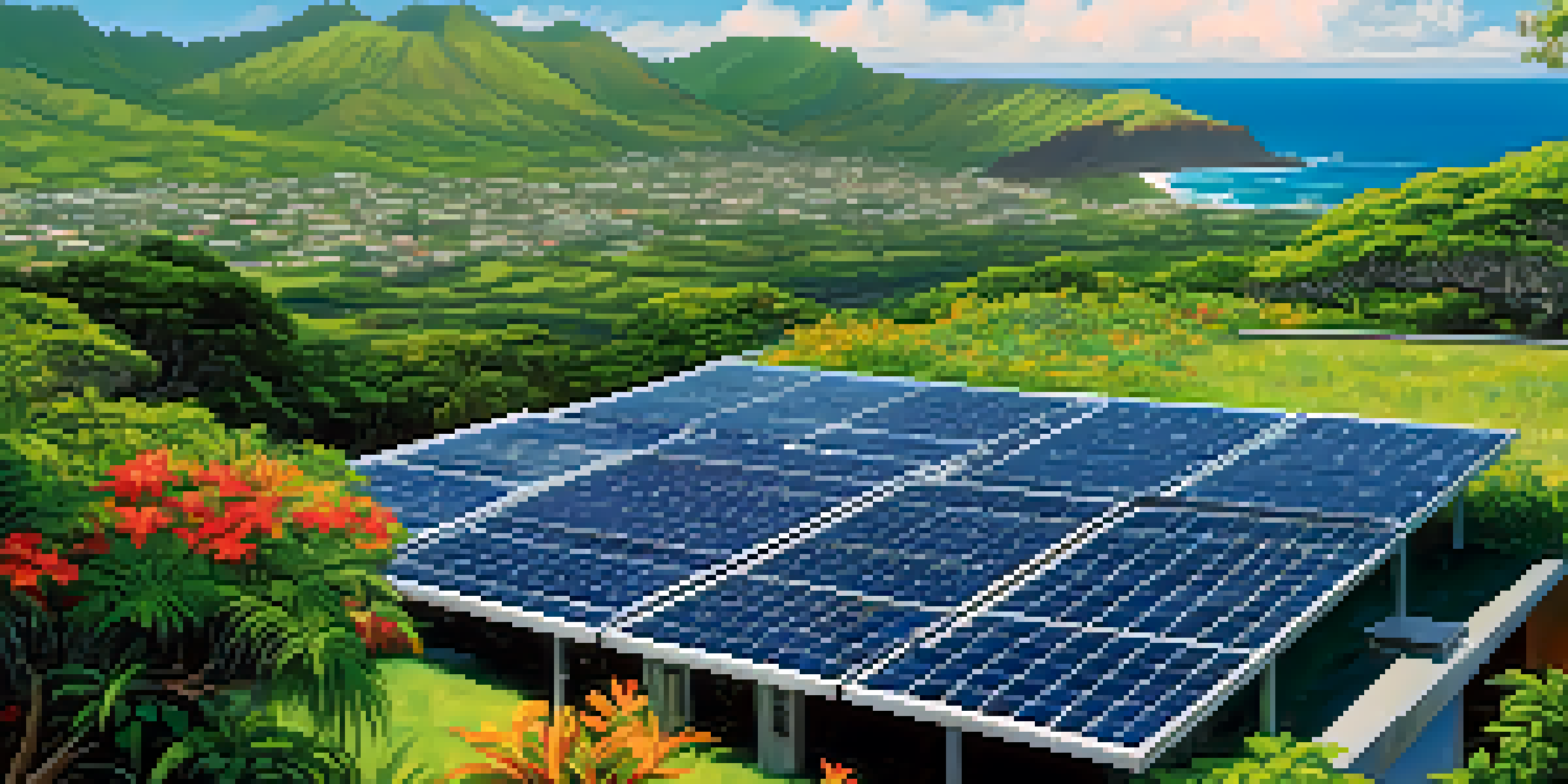Hawaii's Renewable Energy Initiatives for Climate Adaptation

Understanding Hawaii's Unique Climate Challenges
Hawaii faces distinct climate challenges, including rising sea levels and increased storm frequency. These issues threaten not only the islands' natural beauty but also the livelihoods of its residents. As a result, the state is at the forefront of developing innovative solutions to adapt to these changes.
The greatest threat to our planet is the belief that someone else will save it.
The isolation of the Hawaiian Islands means that traditional energy supply routes are vulnerable. This has led to a pressing need for resilience, prompting a shift towards local, renewable energy sources. By embracing renewables, Hawaii aims to create a more sustainable future.
In response to these challenges, Hawaii has initiated various programs focused on renewable energy development. This proactive approach not only addresses climate adaptation but also promotes energy independence and economic growth.
The Role of Solar Energy in Hawaii's Future
Solar energy has become a cornerstone of Hawaii's renewable energy initiatives. The state boasts abundant sunshine, making it an ideal candidate for solar power generation. Homeowners and businesses alike are tapping into this resource, installing solar panels to reduce reliance on fossil fuels.

Hawaii's commitment to solar energy is evident in its ambitious goal to achieve 100% renewable energy by 2045. This long-term vision includes expanding solar installations across the islands, providing clean energy while creating jobs in the green sector. Local programs also incentivize solar adoption, making it a win-win for residents.
Hawaii's Renewable Energy Goals
Hawaii aims to achieve 100% renewable energy by 2045, focusing on solar, wind, and geothermal resources to combat climate change.
By investing in solar energy, Hawaii not only combats climate change but also enhances its energy security. This shift toward renewable sources is crucial for building resilience against the impacts of climate change on the islands.
Harnessing Wind Power for Sustainable Energy
In addition to solar energy, wind power is another key player in Hawaii's renewable energy landscape. The islands' unique geography provides excellent conditions for wind generation, particularly on the northern shores. This natural resource is being harnessed to contribute significantly to the state's energy mix.
We do not inherit the earth from our ancestors, we borrow it from our children.
Hawaii has several wind farms in operation, generating clean electricity and reducing greenhouse gas emissions. These wind projects not only provide energy but also create jobs and stimulate local economies. As technology advances, the efficiency of wind turbines continues to improve, making wind a more viable option.
As Hawaii expands its wind energy capacity, the state enhances its ability to adapt to climate change. Wind power complements solar energy, providing a balanced approach to renewable energy generation that can withstand the islands' environmental challenges.
Geothermal Energy: Tapping into the Earth’s Heat
Geothermal energy is another renewable resource that Hawaii is beginning to utilize more effectively. With its volcanic landscape, the islands have the potential for substantial geothermal energy production. This energy source offers a reliable and consistent supply, unlike solar and wind, which can be intermittent.
Hawaii's geothermal plants are already contributing to the state's energy grid, providing a steady flow of clean energy. By harnessing this natural resource, the state can reduce its dependence on imported fuels and lower energy costs for residents. It also provides an opportunity for local communities to participate in energy production.
Community Engagement is Key
Active community involvement in renewable initiatives fosters a sense of ownership and responsibility, essential for Hawaii's sustainability efforts.
Investing in geothermal energy not only supports Hawaii's climate adaptation efforts but also enhances the resilience of its energy infrastructure. This diversification of energy sources is key to ensuring a sustainable and secure energy future for the islands.
Energy Efficiency: A Crucial Component
Energy efficiency plays a fundamental role in Hawaii's renewable energy strategy. By improving energy efficiency in homes and businesses, the state can significantly reduce overall energy demand. This not only helps in lowering energy costs but also eases the pressure on the energy grid.
Hawaii has implemented various programs to promote energy-efficient practices, such as rebates for energy-efficient appliances and home retrofitting. These initiatives not only encourage residents to adopt sustainable practices but also contribute to job creation in the green sector.
As Hawaii continues to focus on energy efficiency, it creates a more resilient energy system. This proactive approach allows the state to better adapt to climate changes while fostering a culture of sustainability among its residents.
Community Involvement in Renewable Initiatives
Community involvement is crucial to the success of Hawaii's renewable energy initiatives. Local residents and organizations are actively participating in projects that promote sustainability and climate resilience. This grassroots approach helps to foster a sense of ownership and responsibility among residents.
Programs that educate the community about renewable energy options empower individuals to make informed choices. Workshops, outreach campaigns, and local partnerships are all part of Hawaii's strategy to engage the community. By working together, residents can contribute to the state's ambitious renewable energy goals.
Navigating Challenges Ahead
Despite significant strides in renewable energy, Hawaii faces challenges that require collaboration between government, businesses, and the community.
This collective effort not only enhances Hawaii's climate adaptation strategies but also strengthens community bonds. As residents embrace renewable energy, they create a more sustainable future for generations to come.
Challenges and Opportunities Ahead
While Hawaii is making significant strides in renewable energy, challenges remain. The state must navigate issues such as infrastructure development, funding, and the integration of renewable sources into the existing energy grid. Addressing these challenges requires collaboration between government, businesses, and the community.
Despite these hurdles, the opportunities for growth in renewable energy are vast. As technology continues to advance, new solutions for energy storage and distribution emerge, making it easier to transition to a renewable energy system. Additionally, the global focus on sustainability offers Hawaii a chance to lead by example.

By embracing these opportunities, Hawaii can further enhance its climate adaptation strategies. A commitment to overcoming challenges will not only benefit the islands but also serve as a model for other regions facing similar climate issues.
The Path Forward: A Sustainable Future for Hawaii
Hawaii's commitment to renewable energy initiatives for climate adaptation is paving the way for a sustainable future. By harnessing solar, wind, and geothermal resources, the state is not only addressing climate change but also fostering economic growth and energy independence. This holistic approach is vital for the well-being of its residents.
As Hawaii continues to implement innovative energy solutions, community involvement and education will remain essential. Engaging residents in the renewable energy movement ensures that everyone plays a part in shaping a sustainable future. Together, they can build a resilient energy system that can withstand the impacts of climate change.
Looking ahead, Hawaii's renewable energy initiatives serve as a beacon of hope for other regions. By prioritizing sustainability and resilience, the islands are demonstrating that a brighter, greener future is possible for all.